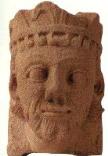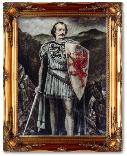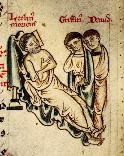See also
- Owain 's parents: Gruffydd ap Cynan (1055-1137) and Angharad Ferch Owain (c. 1065-1162)
- Owain 's siblings: Susanna ( - ) and Gwenllian, Princess of Deheubarth ( - )
Owain (c. 1100-1169)
1. Owain Gwynedd, Prince of Gwynedd, son of Gruffydd ap Cynan (1055-1137) and Angharad Ferch Owain (c. 1065-1162), was born circa 1100. He died on 23 December 1169.
The death of Henry I in 1135 was the signal for more vigorous and more hostile policies by the Welsh, though firm action by Stephen (the king who succeeded Henry) and the marcher lords held the promise of successful defence. Henry II succeeded Stephen in December 1154, determined to restore authority to the kingdom and to repair the damage caused by civil strife and the lack of a strong central administration. By 1157 he was ready to turn his attention to Wales.
Two princes carried Wales through these difficult years, Owain Gwynedd in the north and Rhys ap Gruffydd in south Wales. Both were aware of the complex problems to be faced: to deal with rival Welsh dynasties, to deal with marcher lords, and to live in the shadow of a rich and powerful neighbor. Owain gauged the political realities of the day quickly and, however often he had to yield, he did not lose the initiative.
Owain Gwynedd, Prince of Gwynedd 1137-70, was born circa 1109. In 1137 he succeeded his father Gruffydd ap Cynan (1081-1137) to the kingdom of Gwynedd, which covered most of north Wales. While England was engaged in civil war, Owain used his skill as statesman and soldier to extend his frontiers. In 1157 Henry II led his first campaign against Owain, but it ended in a truce. He was required to do homage to Henry but it was not long before Owain was acting with complete independence. When Madog ap Maredudd died in 1160, he attacked Powys and extended his influence to the east. Six years later, the Council of Woodstock attempted to reduce the Welsh princes from client status to that of dependent vassalage, and the subsequent uprising was led by Owain and Rhys ap Gruffydd of south Wales. Henry's second attempt at subduing Wales failed ignominiously and left Owain free to capture Basingwerk and Rhuddlan castles (1166-67). In 1168 he set foot on negotiations with Louis VII of France to build an alliance between Gwynedd and France against their common enemy. It was a course which required great finesse and firm judgement. In one direction it pointed to a policy which would be used to good effect by later rulers of Gwynedd, the search for recognition and an alliance in Europe. Having openly defied Henry in 1168 by offering to help Louis, Owain maintained his independent position until his death. He left behind him a reputation of wisdom and magnanimity.
The reign of Owain Gwynedd marks the most peaceful period of Welsh independence, when the native princes absorbed many of the current European reforming ideas and adapted the more effective structures of both church and state to their own society. Monastic foundations were encouraged, diocesan boundaries defined, and many stone churches built. Motte-and-bailey earthwork castles identical to those built earlier by the Norman invaders were now erected by the princes as the centers of many of their personal estates. Two of Owain's sons are credited with building the first stone castles in Gwynedd towards the end of the 12th century. The tragedy, recurrent in Welsh history, was that Owain was not followed immediately by a strong ruler. Upon his death in 1170, open warfare broke out between his sons: Dafydd and Rhodri killed their elder half-brother, Hywel, and for the next 20 years Gwynedd was divided between them and their kinsmen. Gwynedd and Wales would not see another strong leader until Llywelyn the Great extended his control over most of Wales in the later part of the century.
Owain Gwynedd, Prince of Gwynedd had the following children:
| +2 |
Second Generation
2. Iorwerth DRWYNDWN, son of Owain Gwynedd, Prince of Gwynedd, was born in 1145 in Aberffraw Castle, Inys Mon. He married Margred Ferch Madog circa 1163. He died circa 1174.
Margred Ferch Madog, daughter of Madog ap Maredydd ( - ) and Susanna Ferch Gruffydd ( - ), was born circa 1129. She and Iorwerth DRWYNDWN had the following children:
| +3 | Llywelyn "Mawr" ap Iorwerth PRINCE OF NORTH WALES (1173-1240) |
Third Generation
3. Llywelyn "Mawr" ap Iorwerth PRINCE OF NORTH WALES The Great, son of Iorwerth DRWYNDWN and Margred Ferch Madog, was born in 1173. He had the title 'Prince of North Wales'. He died in 1240. He married Gwenllian. He married Joan PLANTAGENET.
Llywelyn ap Iorwerth, Prince of North Wales also went by the nick-name of Llywelyn 'the Great'. He gained the title of Prince Llywelyn of North Wales. He hanged the Anglo-Norman baron, William de la Braose, for having an affair with his wife.
Nothing in the Middle Ages more weakened Wales’s chances of emerging as an independent state than the prevailing rules of inheritance. Instead of land and titles passing to the eldest son, everything was divided up among competing heirs. Although sharing laws, customs and language, seldom were the Welsh united under a single dominant ruler.
This was the situation faced by Llywelyn ap Iorwerth when he inherited one third of the ancient kingdom of Gwynedd. Yet by the age of 27 he was the most powerful figure in northern Wales. He defeated his uncle Dafydd in battle and, benefiting from the death of a cousin, took control of all of Gwynedd.
Llywelyn was as astute a political manipulator as any medieval prince. He befriended King John of England, assisted in his campaign against the Scots and married Joan, his illegitimate daughter. It all strengthened Llywelyn’s hand within Wales and helped him seize control of Powys and Ceredigion.
Known to history as a weak and vacillating ruler, John was not a dependable ally. He turned against Llywelyn and having marched into northeast Wales, defeated him in battle. It was the cue for the Welsh to rise up and unite behind Llywelyn.
John was also under internal pressure from his barons. The treaty of Magna Carta in 1215 led to a period of civil strife in England that yielded considerable dividends for Llywelyn. He regained control of the lands he had lost and marched his army into Shrewsbury.
Over the next three years Llywelyn extended his power base into the south, and circumscribed the authority of the Marcher Lords. He became unquestionably the single most powerful figure in Wales, a status recognised by the Treaty of Worcester in 1218.
More than just an opportunistic warlord, Llywelyn refined Wales’s laws and patronised its bards. On the shifting sands of Welsh medieval power politics, he laid strong foundations on which his grandson, Llywelyn ap Gruffudd would build.
Gwenllian was the daughter of Endyfed Fychan ( - ).
Joan PLANTAGENET was the daughter of John Lackland KING OF ENGLAND (1167-1216) and Isabelle Tallefer of Angouleme ( - ). She and Llywelyn "Mawr" ap Iorwerth PRINCE OF NORTH WALES had the following children:
| 4 | Helen ( -aft1294). Helen died after [Julian] February 1294. |


